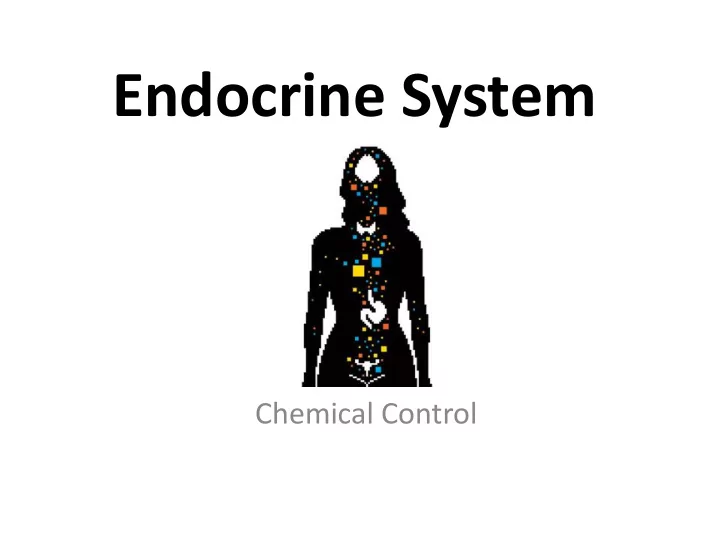

Endocrine System Chemical Control
Endocrine System • A system glands that release chemical messengers ( hormones ) to coordinate body functions • 10 major endocrine glands • Hormones are necessary for cell communication and coordination of cell processes
Chemical Messengers
Function of the Endocrine System • Regulates the growth, metabolism, development and overall function of the human body • Works closely with the nervous system to maintain homeostasis through feedback mechanisms
Nervous Versus Endocrine Use the diagram on p. 648 to compare and contrast the nervous and endocrine systems
Hormones • Chemical messengers that are transported in the circulatory system • Produced and secreted by endocrine glands • Target a variety of cells to have multiple effects ( target cells ) • Long distance signaling
Hormones
Hormone Classification • Classified based on their solubility and chemical structure Hormones Lipid Water Soluble Soluble Proteins and Steroids Amines Peptides
Peptides Proteins Amines Steroids
Hormone Classification Chemical Type Structure Example Peptides/Proteins Chains of amino Insulin, Glucagon, acids Growth Hormone, ADH Amino Acid One or two amino Epinephrine, Derivatives acids Norepinephrine, (Amines) Melatonin Steroids Synthesized from Testosterone, cholesterol Estrogen, Cortisol (Glucocorticoid)
Water Soluble (Peptides, Proteins, Amines) • Target a protein receptor on the cell surface • Initiate signal transduction pathway that may involve a second messenger (cAMP) • Cellular response • Faster response than lipid soluble hormones
Lipid Soluble (Steroids) • Diffuse through plasma membrane • Binds to a receptor in cytoplasm or nucleus • Complex acts as a transcription factor that regulates gene expression • Slower response because of the regulation of gene activity
Significant Endocrine Glands
Significant Endocrine Glands 1. Hypothalamus: Connects nervous system to endocrine system, receives information and sends out nervous or endocrine signals, controls the pituitary gland 2. Pituitary Gland: Composed of nervous and endocrine tissue, “master gland”, releases 9 different hormones
Hypothalamus
Pituitary Gland
Feedback Mechanisms
Feedback Mechanism • Self-regulating mechanism that increases or decreases the level of a particular substance 1. Positive Feedback: Enhances an already existing response 2. Negative Feedback: Maintains homeostasis, common in the endocrine system
Positive Feedback Example
Negative Feedback Examples • Blood glucose levels – insulin and glucagon • Blood volume (water) – anti-diuretic hormone (ADH)
Blood Glucose Levels: Controlled by the action of insulin and glucagon
Kidney Structure
Melatonin • Controls rhythmic activities, such as sleep/wake cycles
Growth Hormone • Controls growth and other metabolic functions by stimulating protein synthesis
Epinephrine (Adrenaline) • Responding to stress or emergencies
Watch the following two videos on the endocrine system and hormone communication Crash Course: Endocrine System Hormonal Communication
Recommend
More recommend